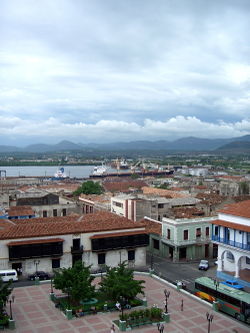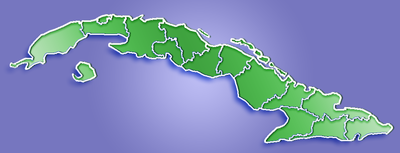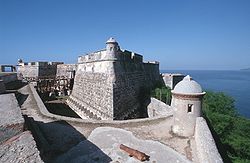Santiago de Cuba
| Santiago De Cuba | |
|---|---|
| — Municipality — | |
 |
|
 |
|
| Coordinates: | |
| Country | Cuba |
| Province | Santiago de Cuba |
| Established | 1514 |
| Area | |
| - Total | 1,023.8 km2 (395.3 sq mi) |
| Elevation | 82 m (269 ft) |
| Population (2004)[1] | |
| - Total | 472,255 |
| - Density | 461.3/km2 (1,194.8/sq mi) |
| Area code(s) | +53-22 |
| Website | Santiago.cu |
Santiago de Cuba is the capital city of Santiago de Cuba Province in the south-eastern area of the island nation of Cuba, some 540 miles (870 km) east south-east of the Cuban capital of Havana.
The municipality extends over 1,023.8 square kilometers (395.3 sq mi)[2], and contains the communities of El Caney, Guilera, Antonio Maceo, Bravo, Castillo Duany, Leyte Vidal and Moncada.[3]
Historically Santiago de Cuba has long been the second most important city on the island after Havana, and still remains the second largest. It is on a bay connected to the Caribbean Sea and is an important sea port. In 2004 the city of Santiago de Cuba had a population of about 494,337 people[4].
Contents |
History

Santiago de Cuba was founded by Spanish conquistador Diego Velázquez de Cuéllar on June 28, 1514. In 1516 the settlement was destroyed by fire, and was immediately rebuilt. This was the starting point of the expeditions led by Juan de Grijalba and Hernán Cortés to the coasts of Mexico in 1518, and in 1538 by Hernando de Soto's expedition to Florida. The first cathedral was built in the city in 1528. From 1522 until 1589 Santiago was the capital of the Spanish colony of Cuba.
The city was plundered by French forces in 1553, and by British forces under Christopher Myngs in 1662.
The city experienced an influx of French immigrants in the late 18th century and early 19th century, many coming from Haiti after the Haitian slave revolt of 1791. This added to the city's eclectic cultural mix, already rich with Spanish and African culture.
It was also the location where Spanish troops faced their main defeat at San Juan Hill on July 1, 1898, during the Spanish-American War. Spain later surrendered to the United States after the destruction of its Atlantic fleet just outside Santiago's harbor.
Cuban poet, writer, and national hero, José Martí, is buried in Cementerio Santa Efigenia.
Role in the Cuban Revolution

Santiago was also the home of the revolutionary hero, Frank País. On July 26, 1953, the Cuban Revolution began with an ill-prepared armed attack on the Moncada Barracks by a small contingent of rebels led by Fidel Castro. Shortly after this disastrous incident, País began talking with students and young working people informally, drawing around him what became an extremely effective urban revolutionary alliance. This developed into highly organized cells coordinating a large scale urban resistance that became instrumental in the success of the Cuban Revolution.[5]
País' group prepared carefully, accruing weapons, collecting money, collecting medical supplies. They published a cheap newsletter that reported news that criticized the government, attempting to counter Batista's censorship.[6]
In the summer of 1955, País’ organization merged with Castro's July 26 Movement. País became the leader of the new organization in Oriente province.
On January 1, 1959, Fidel Castro proclaimed the victory of the Cuban Revolution from a balcony on Santiago de Cuba's city hall.
World Heritage Site
The local citadel of San Pedro de la Roca is inscribed on the UNESCO World Heritage List as "the most complete, best-preserved example of Spanish-American military architecture, based on Italian and Renaissance design principles".[7]
World Heritage Biosphere Reserve
The Baconao Park was inscribed on the UNESCO World Heritage Biosphere Reserve List in 1987.[8]
Climate
| Climate data for Santiago de Cuba | |||||||||||||
|---|---|---|---|---|---|---|---|---|---|---|---|---|---|
| Month | Jan | Feb | Mar | Apr | May | Jun | Jul | Aug | Sep | Oct | Nov | Dec | Year |
| Source: weather.com [9] | |||||||||||||
Demographics
In 2004, the municipality of Santiago de Cuba had a population of 494,337.[1] With a total area of 1,024 km2 (395 sq mi), it has a population density of 482.8 /km2 (1,250 /sq mi).
Notable natives and residents
- Faizon Love - television/film actor, comedian
- Desi Arnaz - television/film actor, producer and bandleader
- Charles Ashenoff - professional wrestler
- Emilio Bacardí - industrialist and philanthropist
- Emilio Estefan - music producer and husband of singer Gloria Estefan
- José María Heredia y Heredia - poet
- Pancho Herrera- professional baseball player
- Alberto Juantorena - Olympic gold medallist, 1976 Olympics
- La Lupe - salsa singer
- Rita Marley- singer and wife of reggae singer Bob Marley
- José Martí - independence hero; interred in Santiago de Cuba
- Frank Pais - revolutionary and urban organizer for the 26th of July Movement
- Antonio Rente - Founder of the Rente Thermoelectric Power Plant
- Jorge Reyes - author
- Esteban Salas y Castro - Baroque composer
Transportation
Santiago is served by Antonio Maceo Airport.
Schools
The main secondary education institution is the University of Santiago de Cuba (Universidad de Oriente - Santiago de Cuba, UO).
See also
- Battle of Santiago de Cuba, 1898
- List of places in Cuba
- Carnaval of Santiago de Cuba
- Oriente
References
- ↑ 1.0 1.1 Atenas.cu (2006). "2004 Population trends, by Province and Municipality". http://www.atenas.inf.cu/todo/Estadisticas/TABLA%20No_3balance.htm. Retrieved 2007-10-05. (Spanish)
- ↑ Santiago.cu (2006). "Municipalities of Santiago de Cuba". http://www.santiago.cu/nuestrostgo/Municipio/2.htm. Retrieved 2007-10-05. (Spanish)
- ↑ Guije.com. "Palma Soriano". http://www.guije.com/pueblo/municipios/opalma/index.htm. Retrieved 2007-10-05. (Spanish)
- ↑ Cuba demographics
- ↑ Cannon, Terrance (1981). "Frank País and the Underground Movement in the cities". historyofcuba.com. http://www.historyofcuba.com/history/pais.htm. Retrieved 2006-05-21.
- ↑ "Who was Frank Pais?". historyofcuba.com. 1981. http://www.historyofcuba.com/history/pais.htm. Retrieved 2006-05-21.
- ↑ World Heritage Site
- ↑ Heritage Biosphere Reserve Site
- ↑ "Average Weather for Santiago de Cuba, --Temperature and Precipitation". weather.com. http://www.weather.com/outlook/travel/businesstraveler/wxclimatology/monthly/graph/CUXX0010?from=36hr_bottomnav_business. Retrieved 2008-06-22.
External links
- Tourist info and news about Santiago de Cuba
- Online travel guide for Santiago de Cuba
- Homepage
- Municipality webpage (Spanish)
 |
Palma Soriano | San Luis | Songo-La Maya El Caney |
 |
| Guamá | Caimanera | |||
| Puerto de Santiago | Puerto Siboney Caribbean Sea |
Guantánamo Bay Windward Passage |
|
||||||||||||||||||||
|
|||||||